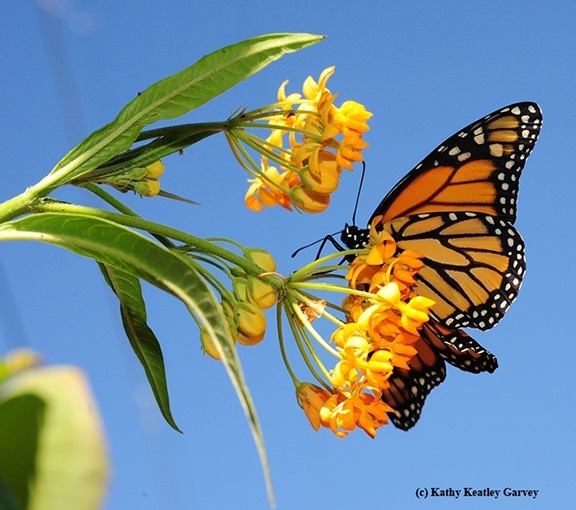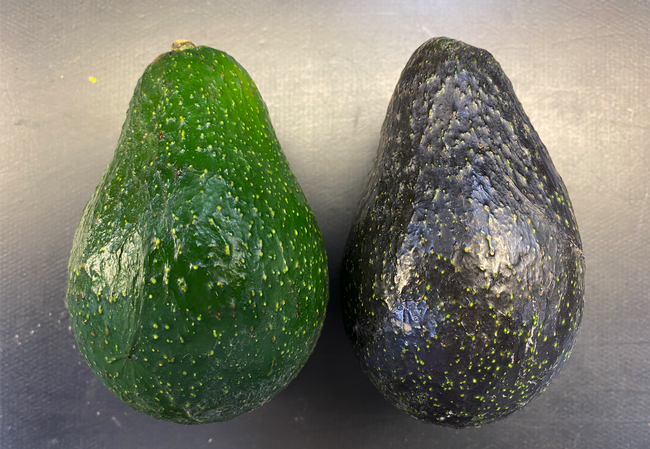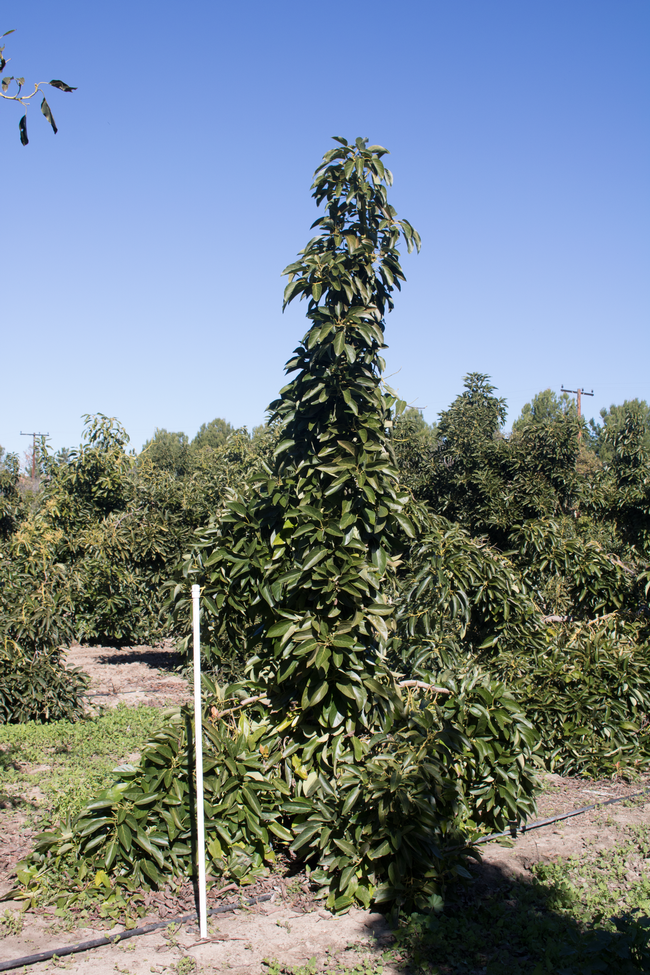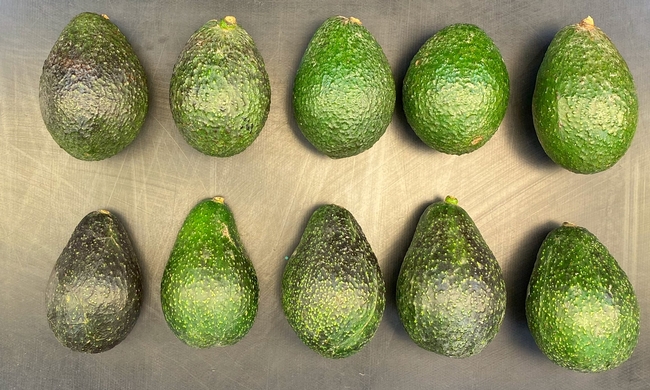Posts Tagged: riverside
Adler Dillman: Of Monarchs, Toxins, and Nematode Parasitism of Insects
"Target-site insensitivity (TSI) is an important mechanism of animal resistance to toxins," says nematologist Adler Dillman of the University of California, Riverside. "TSI evolved in parallel in the monarch butterfly and other...

Monarch butterfly nectaring on milkweed in a Vacaville garden. (Photo by Kathy Keatley Garvey)
First Seminar of 2024: Adler Dillman to Speak on Nematode Parasitism of Insects
Nematologist Adler Dillman of UC Riverside will present the UC Davis Department of Entomology and Nematology's first seminar of the year at 4:10 p.m., Monday, Jan. 8 on "Nematode Parasitism of Insects with Toxic Cardenolides." His seminar will...
New avocado proves tasty, safer to harvest at UC ANR Research and Extension Centers
A new avocado, one that complements the widely known ‘Hass,' will hit the world market soon. The ‘Luna UCR' variety (trademarked and patent pending) has several characteristics that should be of interest to both growers and consumers, said Mary Lu Arpaia, University of California Cooperative Extension subtropical horticulture specialist based at UC Riverside.
From the grower perspective, the tree is about half the size of the leading variety while producing approximately the same yield per tree as ‘Hass,' meaning that growers could plant more trees per acre, therefore increasing yield. It also makes harvesting easier and safer.
Another advantage is the flowering behavior of the tree. Avocado trees are categorized into either Type A or Type B flower types. It is generally accepted that you need both flower types in a planting to maximize productivity. The ‘Hass' is an “A” flower type and ‘Luna UCR' is a Type “B.”
This is a potential boost for growers since the current varieties that are “B” flower types ripen green and generally receive lower prices for the grower. Similar to ‘Hass,' however, the ‘Luna UCR' colors as it ripens.
“Hopefully, it will receive similar returns to the ‘Hass' once it is an established variety,” Arpaia added.
Fruit breeding is a long-term process that she has navigated by building upon the work of her predecessors. Of course, Arpaia has had strong support from colleagues as well, including Eric Focht, a UC Riverside staff researcher and co-inventor of ‘Luna UCR.'
“We had been looking at ‘Luna UCR' for some time and it was always a very good eating fruit,” Focht said. “After the 2003 release of ‘GEM' (registered and patented as ‘3-29-5', 2003) and ‘Harvest' (patented as ‘N4(-)5', 2003) varieties, ‘Luna UCR' was always the top contender for a next release due to the small, narrow growth habit, “B” flower type and the fruit quality.”
“It's a very nice-looking fruit as well and seemed to be a pretty consistent bearer from year to year.”
A glimpse at how it all started
In spring 1996, Arpaia took over the UC Avocado Breeding Program following Guy Witney who led the program from 1992 to 1995, and Bob Bergh whose initial efforts in the 1950s were foundational in the inception of ‘Luna UCR.'
Arpaia recalls the first trials in the early 2000s of ‘Luna UCR,' which were tested alongside other promising selections from the Bergh program. “There were a lot of varieties that didn't perform well, some of which had poor storage life, an important trait that we need if we are going to get the fruit to consumers across the country,” said Arpaia.
The original seed and selection were planted at the Bob Lamb Ranch in Camarillo, and originally advanced trials of the ‘Luna UCR' variety were planted in four locations: UC Lindcove Research and Extension Center in Tulare County, UC South Coast Research and Extension Center in Orange County, a privately owned farm in San Diego County and another one in Ventura County.
The RECs are among the nine hubs operated by UC Agriculture and Natural Resources to support research and educate the public on regional agricultural and natural resource challenges.
ANR Research and Extension Centers become vital
Unfortunately, the 2017 Thomas Fire burned the avocado trees in Ventura, said Arpaia. After a change in management, the trial located in San Diego County was also terminated, leaving the two trials at Lindcove and South Coast REC.
“South Coast REC has a long history of supporting research and extension activities of high value crops important to California, including avocados,” said Darren Haver, director of the South Coast REC, which was often used to show growers the new varieties that were being developed.
“Many of the REC staff have worked with the avocado-breeding program researchers for more than two decades and continue to work closely with them to ensure the success of new avocado varieties, including ‘Luna UCR',” he added.
In addition to the support provided by South Coast and Lindcove RECs, Arpaia said that UC Kearney Agricultural Research and Extension Center in Fresno County – another UC ANR facility – made it possible for her team to conduct critical postharvest and sensory research, and consumer testing of the fruit, which included up to six-week trials of fruit ratings for storage life and taste.
“UC ANR has played an important role in our ability to not only identify ‘Luna UCR', but in preparing it for the world market, too,” she said.
Preparing to share with the world
Since 2015, Focht had been collecting data for the patent application. Now that he and Arpaia have successfully patented and trademarked ‘Luna UCR,' they are preparing to expand production by engaging interested growers with the commercial partner, Green Motion who is based in Spain.
“Green Motion contracted for 1,000 trees to be generated by Brokaw Nursery and those trees are currently being distributed, with earliest field plantings likely taking place in fall,” explained Focht.
Focht also said that Mission Produce, based in Oxnard, CA has contracted to graft over a small number of “B” flower type pollinizer trees to the new ‘Luna UCR' variety, possibly making way for a small number of avocados to be available the following year.
Once planted, the avocado trees will come into “full” production in about five years.
To read this story in Spanish, visit: https://ucanr.edu/blogs/blogcore/postdetail.cfm?postnum=58991
Climate-Change Resources
University of California UC ANR Green Blog (Climate Change and Other Topics) https://ucanr.edu/blogs/Green/index.cfm?tagname=climate%20change (full index)
Examples:
- Save Trees First: Tips to Keep Them Alive Under Drought https://ucanr.edu/b/~CdD
- Landscaping with Fire Exposure in Mind: https://ucanr.edu/b/~G4D
- Cities in California Inland Areas Must Make Street Tree Changes to adapt to Future Climate https://ucanr.edu/b/~oF7
Drought, Climate Change and California Water Management Ted Grantham, UC Cooperative Extension specialist (23 minutes) https://youtu.be/dlimj75Wn9Q
Climate Variability and Change: Trends and Impacts on CA Agriculture Tapan Pathak, UC Cooperative Extension specialist (24 minutes) https://youtu.be/bIHI0yqqQJc
California Institute for Water Resources (links to blogs, talks, podcasts, water experts, etc.) https://ciwr.ucanr.edu/California_Drought_Expertise/
UC ANR Wildfire Resources (publications, videos, etc.) https://ucanr.edu/News/For_the_media/Press_kits/Wildfire/ (main website)
-UC ANR Fire Resources and Information https://ucanr.edu/sites/fire/ (main website)
-Preparing Home Landscaping https://ucanr.edu/sites/fire/Prepare/Landscaping/
UC ANR Free Publications https://anrcatalog.ucanr.edu/ (main website)
- Benefits of Plants to Humans and Urban Ecosystems: https://anrcatalog.ucanr.edu/pdf/8726.pdf
-Keeping Plants Alive Under Drought and Water Restrictions (English version) https://anrcatalog.ucanr.edu/pdf/8553.pdf
(Spanish version) https://anrcatalog.ucanr.edu/pdf/8628.pdf
- Use of Graywater in Urban Landscapes https://anrcatalog.ucanr.edu/pdf/8536.pdf
- Sustainable Landscaping in California https://anrcatalog.ucanr.edu/pdf/8504.pdf
Other (Non-UC) Climate Change Resources
Urban Forests and Climate Change. Urban forests play an important role in climate change mitigation and adaptation. Active stewardship of a community's forestry assets can strengthen local resilience to climate change while creating more sustainable and desirable places to live. https://www.fs.usda.gov/ccrc/topics/urban-forests
Examining the Viability of Planting Trees to Mitigate Climate Change (plausible at the forest level) https://climate.nasa.gov/news/2927/examining-the-viability-of-planting-trees-to-help-mitigate-climate-change/
Reports and other information resources coordinated under the auspices of the United Nations and produced through the collaboration of thousands of international scientists to provide a clear and up to date view of the current state of scientific knowledge relevant to climate change. United Nations Climate Action
Scientific reports, programs, action movements and events related to climate change. National Center for Atmospheric Research (National Science Foundation)
Find useful reports, program information and other documents resulting from federally funded research and development into the behavior of the atmosphere and related physical, biological and social systems. Search and find climate data from prehistory through to an hour ago in the world's largest climate data archive. (Formerly the "Climatic Data Center") National Centers for Environmental Information (NOAA)
Think tank providing information, analysis, policy and solution development for addressing climate change and energy issues (formerly known as the: "Pew Center on Global Climate Change"). Center for Climate & Energy Solutions (C2ES)
Mapping Resilience: A Blueprint for Thriving in the Face of Climate Disaster. The Climate Adaptation Knowledge Exchange (CAKE) was launched in July 2010 and is managed by EcoAdapt, a non-profit with a singular mission: to create a robust future in the face of climate change by bringing together diverse players to reshape planning and management in response to rapid climate change. https://www.cakex.org/documents/mapping-resilience-blueprint-thriving-face-climate-disaster
Cal-Adapt provides a way to explore peer-reviewed data that portrays how climate change might affect California at the state and local level. We make this data available through downloads, visualizations, and the Cal-Adapt API for your research, outreach, and adaptation planning needs. Cal-Adapt is a collaboration between state agency funding programs, university and private sector researchers https://cal-adapt.org/
Find reports, maps, data and other resources produced through a confederation of the research arms of 13 Federal departments and agencies that carry out research and develop and maintain capabilities that support the Nation's response to global change. Global Change (U.S. Global Change Research Program)
The Pacific Institute is a global water think tank that combines science-based thought leadership with active outreach to influence local, national, and international efforts to develop sustainable water policies. https://pacinst.org/our-approach/
Making equity real in climate adaptation and community resilience policies and programs: a guidebook. https://greenlining.org/publications/2019/making-equity-real-in-climate-adaption-and-community-resilience-policies-and-programs-a-guidebook/
Quarterly CA Climate Updates and CA Drought Monitor Maps (updated each Thursday) https://www.drought.gov/documents/quarterly-climate-impacts-and-outlook-western-region-june-2022
Drought focus of Water Resources IMPACT magazine special issue
UC ANR experts address emotional toll of drought
Preparing the American West for prolonged drought is the focus of a double issue of Water Resources IMPACT magazine. The California Water Commission staff are guest editors for this special open-access edition of the magazine, which is published by the American Water Resources Association.
Faith Kearns, academic coordinator of University of California Agriculture and Natural Resources' California Institute for Water Resources, is among the authors delving into how drought impacts people and the environment and how we can better prepare for the inevitable.
The first issue, published on Feb. 14, focuses on water scarcity issues confronting California and the ways these issues affect different sectors.
In “Trauma, Care, and Solidarity: Addressing the Emotional Toll of Chronic Drought,” Kearns highlights the effects of drought on mental health. She points to the spike in suicide hotline calls when wells ran dry in Southeast Asian communities in California's Central Valley.
By listening to Southeast Asian farmers, Ruth Dahlquist-Willard and Michael Yang of UC Cooperative Extension were able to “lighten the load” for them by providing pragmatic support, Kearns writes.
“The scale of some of these highly emotional issues – drought, wildfires, climate change – can make them seem incredibly difficult, if not impossible, to deal with,” Kearns said. “At the same time, they are affecting everyone living in the western U.S. on a daily basis. I wanted to highlight and provide models based on work that people – whether they are researchers, clinical psychologists, or Cooperative Extension advisors – are doing right now to ease the way.”
The authors who contributed to the double issue are a diverse array of Tribal experts, academics, nongovernmental organization thought-leaders, water managers and water policy influencers, each of whom brings their own perspective on the topic of drought. Their expertise and perspectives in climate science, water policy and water management will help inform drought-related decision-making and support policies that better prepare the state to thrive during periods of prolonged water scarcity.
In addition to Kearns, the first issue includes articles contributed by:
- Samantha Stevenson, University of California, Santa Barbara
- Jay Lund, University of California, Davis
- Ron Goode, North Fork Mono Tribe
- Andy Fecko, Placer County Water Agency
- Jeff Mount, Public Policy Institute of California, and Ted Grantham, University of California, Berkeley/UC Cooperative Extension
- Nat Seavy and Karyn Stockdale, National Audubon Society
- Kjia Rivers, Community Water Center
- Cannon Michael, Bowles Farming
- Michelle Reimers, Turlock Irrigation District
The January/February edition of Water Resources IMPACT magazine can be accessed, free of charge, on the American Water Resources Association website at https://www.awra.org under “Publications.”
The second issue, to be published in March, will focus on drought response, considering the options for adaptation. This two-part series complements the Commission's work on strategies to protect communities and fish and wildlife in the event of a long-term drought.






